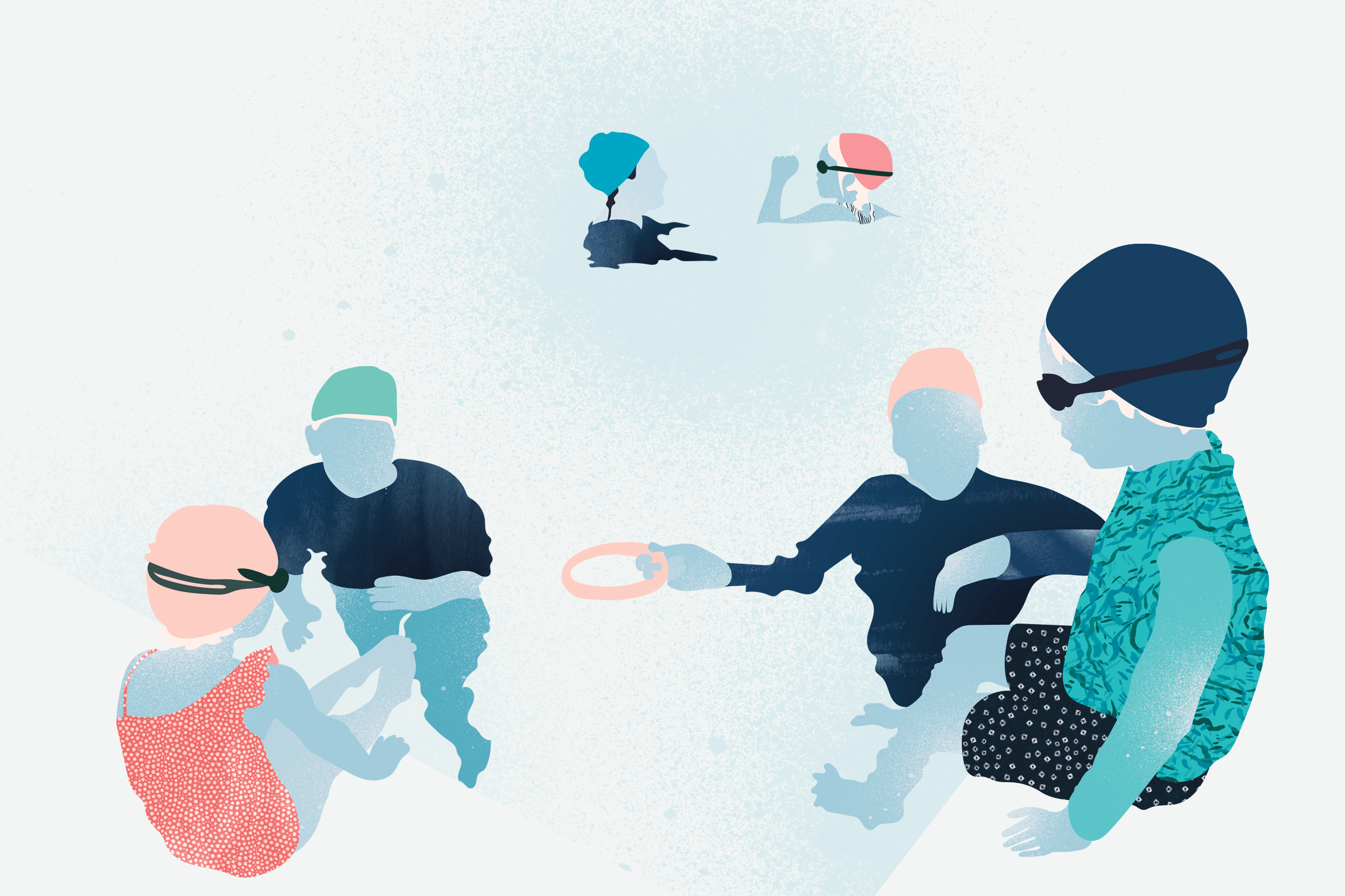So you're ready to introduce your child to our nation's favourite past-time? Y A Y ! ?
We're always excited to introduce newbies to the magic and wonder of being in the water, and learning to swim. We're honoured to be part of their swimming journey.
We thought we'd set the record straight on what you might be expecting at our learn to swim assessment.
This is for those kids who are new to swimming, or may have experienced some swimming; playing in the backyard pool, down at the beach or a few lessons.
Unfortunately there's a lack of consistency and transparency in the swimming industry, which makes this daunting activity more difficult and confusing than it needs to be! With twenty years under our belts, we're aware of the misconceptions we need to unravel so that your child has the best foundational experience in the water.
Swimming involves movement, and so it's perfectly normal to assume that that's where we start when we learn to swim. You might be picturing your son to be as good in the pool, as they were the other day in the backyard pool with Dad, that they can in fact, swim. Or maybe you've seen your daughter swimming on her own, diving under and dog paddling elsewhere, and so you naturally think she should be placed in an equivalent level.
These assumptions make perfect sense.
But without expert eyes, there's a couple of factors most parents aren't aware of when they come to us for an assessment.
Our different approach to most swim schools, coupled with swimming in a strange new, structured environment will determine what level is best suited to a child's individual abilities – and it's not always the level you were expecting.
Our mission at In The Deep is to develop relaxed, graceful swimmers.
We guide kids of all ages, abilities and backgrounds towards a positive relationship with the water. And those good vibes with the water start with tossing out the industry standard – an outdated, overwhelming, even damaging, 'teach-everything-all-at-once' approach, where poor techniques and habits reign, where kids panic and fear the water, missing the opportunity to be taught that water can be their happy place.
Before we move, we must float!
Instead, our philosophy is to slow kids down in the water so that they get to experience the wonder of this new world, and find themselves at ease when they're learning to swim. Before we add movement, we want to ensure the foundations are in place. We want kids to feel safe, and to understand and feel their buoyancy. It's the difference between a child gliding gracefully through the water, and fighting it the whole way to the wall.
The pool is a strange new environment.
Even though your child might be happy playing at the beach or in the backyard pool, this is a different experience. It's strange, it's a very big pool, and there's lots going on there. Most kids will naturally be nervous and excitable. Many are fearful, and some so much so that they won't get in the water the first time. And that's ok!
Because we're all about creating relaxed swimmers, we'll never force them. We play and give them time to get familiar with the pool and teachers. Lots of toys, smiles and our secret knack are involved in building their trust and making sure they feel safe.
We're not going to push them to do anything that could scare them. We're not concerned with them learning anything at this stage, instead, it's about developing trust. We'll never push a child in and get them swimming when they're really nervous – this goes completely against our core value of feeling at ease in the water. And if at first we don't succeed in getting them in the water, we try again, another day. Usually it doesn’t take too long!
If they resist or don’t remember, they really can’t swim.
Recently I was assessing a little boy, whose parents assured me that he could swim. They informed me he was swimming on his own, diving under and the teacher he had a couple of lessons with, had no problem getting him to swim. But when it came time to be in the water, he was holding onto me for dear life. He was petrified at the suggestion of putting his face under the water and letting go of me.
When kids learn to be comfortable in the water, it's a learnt behaviour. It's not dependent on the teacher, the parent or anyone else to push them — or even force them — to let go. If a child feels safe and knows that they can float, they'll swim on their own. But, if a child doesn't feel safe they won't let go.
It's common to assess children who've been pushed to swim on their own before they're comfortable and have the skill. So yes, while you may have seen your child swimming, in the backyard pool, or at other swim lessons, it's more likely to have been a distressing experience, where they're panicking and fearful – which is not a space for learning.
Before getting them to add movement, we want them to feel safe, at ease and in control of this new environment. They need to understand their body's buoyancy in the water, to become a relaxed swimmer. They might be able to swim, but what we're looking for, is if they're a relaxed swimmer.
“There is no learning without remembering.” – Socrates
This is also something you might find surprising. You're sure they can swim, but with expert eyes, we're looking for a particular set of criteria. A key one is, can they remember to do what you've asked of them? If a child can't recall how to put their face in the water, front or back float, in a structured environment where you're asking them to demonstrate their ability, they're not capable of doing it independently. If they can't remember, they can't do it. The good news is that once your child can remember, they're going to be ready to move up a level. This can happen in a matter of weeks!
So what else are we looking for in assessments? What does a relaxed swimmer look like?
The first thing we're looking at is that kids can really hold their breath under the water. Are they happy to go under the water? Or is there trepidation? If they're nervous, it means we need to build confidence in that area. If kids aren't confident under the water, we won't let them go. If they can't hold their breath and we let them go, they're going to get scared and the last thing you want is a scared kid in the water!
It's not about pushing them to overcome their fears.
Instead, we're here to develop their confidence so they're empowered to do it independently. It's hugely important to us that they feel safe, understood and feel they can trust the teacher.
The second thing we do is let them go to see if they can float. If they're confident floating on their front, that's awesome! These kids are relaxed and doing well. If they're not relaxed, then obviously that's where we need to develop some confidence, so that when we do let them go, they know the water will support them and they're not going to sink.
If a child is thinking they're going to sink, they'll start to panic.
This is what happened to the little boy I was assessing – he didn't trust himself, he was scared, and asking "What's going to happen to me?!"
We believe in having kids learn to float when they're relaxed. And once you've broken that barrier with children and they're happy to float, it's beautiful! It's beautiful for the child to experience it for themselves and to get a feel for the freedom, the ease that we want them to feel. It's a completely different journey to getting kids to panic and swim to the wall!
The majority of kids are going to be at this stage where they probably do panic when we let them go. There's a learning curve here, to be able to be relaxed and happy just floating. Being a relaxed swimmer is an understanding of your buoyancy in the water, and that takes time.
Why we may need to go back in order to move forward when we’re learning to swim.
If we push kids up a level before they can achieve what we're looking for, they're missing out. We believe passionately in bringing people — of all generations — together, through the wonders of being in the water. Our vision helps us to focus on developing confident, relaxed, graceful swimmers so that, they too can partake in and grow up to love, respect and feel at ease in the water. It may mean that we do need to reach into some fundamentals, before we move forward, but your child will associate the water with a positive experience and develop beautiful technique. To us, that's a win!
Our levels are a reflection of our philosophy – they're designed to support a harmonious relationship with the water, where children progress when they've mastered a particular piece to a complex skill. Each level is a progression of difficulty, and aren't linked to a timeframe – as soon as they've learnt it, they move up immediately. They can move up within weeks, if they've learnt how to do it.
Our levels are not designed to be a competition, an indication of where your child should be at, at a certain age or something to lord over a sibling who may not be as fast. Every child is on a different journey! There'll be something that is going to be a little bit more challenging for some and easy for others, and vice versa. Age is irrelevant. Some kids have less co-ordination so things will take longer. Some kids will seem like a mini-Michael-Phelps and be doing things faster at a younger age.
It's all about skill, ability, and what their body can do. And if their body can't do it and needs more time, then it's all good! They'll still get there in the end. If you trust in the process they'll enjoy it more, too!
The key thing to remember here is that body position in the water should come before movement.
If you add movement before kids can float, you're going to have problems. Our program focuses on getting the body positioned beautifully in the water first. Movement's easier with buoyancy mastered.
We want every child to feel supported, understood and love the water as much as we do.
The assessment is not a space for judgement, expectations or shame for not performing. We want to give every individual child the best chance of loving the water, so our teachers are here to focus in on where they truly need to learn and practice before moving ahead. This is our only concern.
It's our nature to expertly tune in to their needs, to understand their current level of skills and abilities and to place them in the level that will best help them in their swimming journey. We're not going to push kids and we're not going to make them do things they're not ready for.
If you're after really quick push-your-kid-up-fast-and-get-them-to-win-their-year-two-swimming-carnival, doing the worst technique ever and hating every second of it, then we likely won't be a good fit for you.
But, if you do see the value in children learning to be relaxed, easeful swimmers, then we're SO excited at the journey you're about to gift your child with. We're stoked to play a part in developing a positive relationship with the water that we hope will carry on into a lifetime love affair with swimming.
See you in the water! Sasha x



No comments.